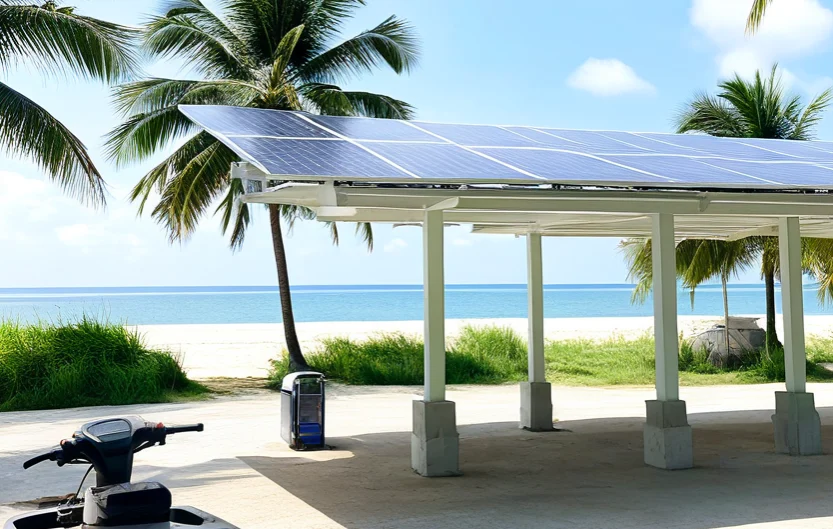With the rapid development of renewable energy, the proportion of clean energy such as wind and solar power in the power system is becoming higher and higher. However, wind and photovoltaic power generation is random and volatile, and direct grid access could affect stability. Microgrid, by integrating distributed power sources (e.g., wind power and photovoltaic), energy storage (e.g., batteries), and intelligent control systems, can achieve efficient use and stable supply of electricity. So how can a microgrid coordinate various energies such as wind, solar and storage to achieve optimization operation? In this article, let’s learn about its key technologies in simple terms.
The structure of a microgrid is generally as follows:
The essence of microgrids is “multi-energy complementarity”, i.e., by leveraging the complementary advantages of various energy sources to improve the reliability of power supply. A general microgrid generally includes the following components:
Photovoltaic power generation: It utilizes solar panels to transform light energy into electric energy. It is ideal for power generation in the daytime but is significantly influenced by the weather.
Wind power generation: Generating electricity through wind turbines, usable at night or in areas where there are high winds, but also volatile.
Energy storage systems (such as lithium batteries) : Charge during periods of excessive power generation and discharge during periods of insufficient power generation, serving as a “buffer.”
Diesel generator/gas turbine: Reserve power supply, ensuring power supply security in extreme situations.
Intelligent control system: Real-time monitoring of power supply and demand, and optimized dispatch of the output of each energy source.
2. How is wind, solar and energy storage coordinated?
Optimized operation of microgrids relies on the Energy Management System (EMS), and its inherent logic is: “Prediction – optimization – scheduling”.
(1) Prediction: Make predictions about power generation and electricity demand ahead of time
Use meteorological data to predict wind speed and luminous intensity in the coming 24 hours and estimate wind power and photovoltaic power output.
Based on historical statistics of electricity consumption, predict the load demand of the microgrid coverage area (e.g., peak electricity use in households and factories).
(2) Optimization: Determine the best energy allocation plan
The microgrid optimization objective is generally:
Economy: Try to use as much low-cost wind power and photovoltaic power and less expensive diesel power generation as possible.
Stability: Maintain the voltage and frequency within a safe range to avoid power outages.
Environmental friendliness: Prioritize the utilization of clean energy and reduce carbon emissions.
Example:
Day with ample sunlight: Photovoltaic power generation is prioritized to provide power, and the excess power is stored in the battery.
Night without light but with wind: Wind power generation becomes the primary source, and batteries are used to supplement the shortfall.
Continuous cloudy days with no wind: Start the energy storage power supply. If still inadequate, employ the diesel generator.
(3) Dispatching: Control the output of each energy source in real time
The intelligent control system is just like a “traffic command center”, adjusting dynamically according to the actual situation:
When the battery will be fully charged, the output of photovoltaic/wind power can be reduced (or sell electricity to the main grid).
In case of abrupt load rise (for example, when a factory starts high-power equipment), immediately start the energy storage or standby power supply.
3. Primary technical concerns
Though microgrids have obvious advantages, to achieve effective coordination, the following concerns still need solving:
The intermittence of wind and solar generation
Abruptly forming dark clouds or a reduction in wind speed will cause the sudden power generation decline, and energy storage is needed to respond to it quickly.
Solution: Adopt more accurate AI algorithms for weather forecasting to enhance the predictive accuracy further.
(2) Durability and cost of energy storage devices
The continuous charge and discharge of lithium batteries will shorten their lifespan and add to their cost.
Solution: Improve charging and discharging techniques (such as shallow charging and shallow discharging), or create new technologies such as hydrogen energy storage.
(3) Coordinated control of multiple energy sources
Photovoltaic, wind power, and energy storage possess diverse characteristics. How are they switched smoothly?
Solution: By the virtual synchronous machine (VSG) technology, the inverter can simulate conventional generators’ working characteristics to enhance stability.
4. Practical application cases
The Fushan Island, Zhoushan, Zhejiang Province microgrid: It is the “photovoltaic + wind power + energy storage + diesel engine” mode, with the renewable energy penetration rate above 90%, basically replacing the use of diesel.
The Zaduo County, Yushu City, Qinghai Province microgrid: It is applied in the high-altitude regions without power and uses photovoltaic power and energy storage for the steady supply of electricity for herdsmen, instead of traditional diesel generators.
5. Future Development Trends
Integrated photovoltaic storage and charging: The combination of photovoltaic, energy storage and charging piles, which can be applied to industrial parks and electric vehicle charging stations.
Ai-optimized dispatching: Microgrid prediction and dispatching efficiency can be enhanced by machine learning.
Participating in the electricity market: Microgrids can earn money from providing peak shaving services for the primary power grid through the “virtual power plant” mode.
Microgrids, through intelligent coordinated optimization of wind, solar, and energy storage, can not only enhance the utilization rate of renewable energy but also ensure the reliability of power supply. Microgrids are an indispensable component of the future energy system. With the reduction of energy storage costs and the development of AI technology, microgrids will play a larger role in applications such as industrial parks, remote locations, and urban distribution systems.

